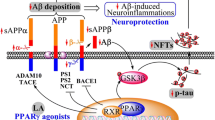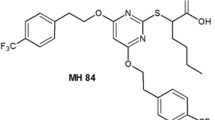Abstract
Objective
To observe the effects of Huannao Yicong Formula (还脑益聪方, HYF) on learning and memory and it’s regulating effect on γ-secretase related anterior pharynx defective 1 (APH-1), presenilin enhancer-2 (PEN-2) signaling pathway, so as to discuss and further clarify the mechanism of HYF on Alzheimer’s disease.
Methods
Sixty APP/PS1 transgenic mice, randomly allocated into 4 groups, the model group, the donepezil group (0.65 mg/kg), HYF low-dose group (HYF-L, 5.46 g/kg) and HYF high-dose group (HYF-H, 10.92 g/kg), 15 for each group. Another 15 C57BL/6J mice with the same age and same genetic background were allocated into the control group, proper dosage of drugs or distilled water were given by intragastric administration once daily for 12 weeks. After 12 weeks of administration, the learning and memory abilities of mice in each group was evaluated by the morris water maze test, amyloid precursor protein (APP), Aβ1-40 and Aβ1-42 levels in hippocampus were detected by enzyme-linked immunosorbent assay, γ-secretase was detected by dual luciferase assaying, the levels of APH-1a, hypoxia-inducible factor 1α (HIF-1α), cAMP response element-binding protein (CREB) and PEN-2 and their mRNA expression was measured by Western blot and real-time polymerase chain reaction.
Results
HYF can ameliorate learning and memory deficits in APP/PS1 transgenic mice by decreasing the escape latency, improving the number of platform crossing and swimming speed (P<0.01, P<0.05). HYF can decrease the levels of APP, Aβ1-40, Aβ1-42 and the activity of γ-secretase in hippocampus of Alzheimer’s disease model mice. HYF can down-regulate the levels of CREB and PEN-2 and the expression of their mRNA.
Conclusion
HYF can improve the learning and memory ability by inhibiting the activity of γ-secretase through the CREB/PEN-2 signaling pathway, and this may be one of the therapeutic mechanisms of HYF in Alzheimer’s disease.
Similar content being viewed by others
References
Alzheimer’s Association. 2015 Alzheimer’s disease facts and figures. Alzheimer’s and dementia. Alzheimers Dement 2015;11:332–384.
James BD, Leurgans SE, Hebert LE, Scherr PA, Yaffe K, Bennett DA. Contribution of Alzheimer disease to mortality in the United States. Neurology 2014;82:1045–1050.
Tayeb HO, Yang HD, Price BH, Tarazi FI. Pharmacotherapies for Alzheimer’s disease: beyond cholinesterase inhibitors. Pharmacol Ther 2012;134:8–25.
Zhang Y, Zhang Y, Lu Y. Systematic review of randomized controlled trials of traditional Chinese medicine in treating Alzheimer’s disease. China J Tradit Chin Med Pharm (Chin) 2012;27:105–109.
Koppel J, Greenwald BS. Optimal treatment of Alzheimer’s disease psychosis: challenges and solutions. Neuropsychiatr Dis Treat 2014;10:2253–2262.
Tanzi RE, Bertram L. Twenty years of the Alzheimer’s disease amyloid hypothesis: a genetic perspecfive. Cell 2005;120:545–555.
Stancu IC, Vasconcelos B, Terwel D, Dewachter I. Models of beta-amyloid induced Tau-pathology: the long and "folded" road to understand the mechanism. Molecular neurodegeneration 2014;9:51.
Barage SH, Sonawane KD. Amyloid cascade hypothesis: Pathogenesis and therapeutic strategies in Alzheimer’s disease. Neuropeptides 2015;52:1–18.
Epis R, Marcello E, Gardoni F, Di Luca M. Alpha, beta-and gamma-secretases in Alzheimer’s disease. Front Biosci (Schol ed) 2012;4:1126–1150
Wang Q, Li H, Wang FX, Gao L, Qin JC, Liu JG, et al. Huannao Yicong decoction extract reduces inflammation and cell apoptosis in abeta-induced Alzheimer’s disease model of rats. Chin J Integr Med (Epub 2016 March 29).
Li H, Liu JG, Liu MF, Liu LT, Guan J, Cai LL, et al. Effects of Huannao Yicong Recipe Extract on the learning and memory and related factors of Aβ generation in the brain of APP transgenic mice. Chin J Integr Med 2013;33:90–94.
Liang L. Effects of Huannao Yicong Fang on PS1 and NCT regulation pathways of APP/PSl double transgenic dementia model mice [dissertation]. Beijing: China Academy of Chinese Medical Sciences; 2013.
Liu MX, Liu JG, Li H, Liu LT, Liang L, Hu J, et al. The effect and mechanism of Huannao Yicong Decoction extract on learning and memory ability in APP/PS1 mouse. Chin J Pharmacol Toxicol (Chin) 2014;28:10–17.
Li H, Liu M, Liu J, Liu L, Guan J, Cai L, et al. Effect of Huannao Yicong Prescription Extract on β-amyloid precursor protein metabolic signal transduction-related protein in brain tissue of dementia model transgenic mouse. Chin J Integr Med 2012;18:683–689.
Wang X, Li H, Liu J, Liu M, Liu L, Hu J, et al. Effects of Huannao Yicong decoction on learning and memory, and the expressions of β-amyloid protein and TTBK1 in aging rats with cognitive impairment. Chin J Integr Med 2015;35:2336–2339.
Tian F, Liang L, Liu J, Li H. Influences of Huannao Yicong Fang on oxidative stress and inflammatory factors of hippocampus in rapid aging mice. J Beijing Univ Chin Med (Chin) 2013;36:752–761.
Lu YZ, Li H, Liu JG, Bi PY, Wei Y. Simultaneous and sensitive quantification of seven active compounds in Huan-Nao-Yi-Cong-Fang and rat serum by UFLC-ESI/MS. Anal Methods 2014;6:5727–5733.
Gao J, Inagaki Y, Li X, Kokudo N, Tang W. Research progress on natural products from traditional Chinese medicine in treatment of Alzheimer’s disease. Drug Discov Ther 2013;7:46–57.
Su Y, Wang Q, Wang C, Chan Ke, Sun Y, Kuang H. The treatment of Alzheimer’s disease using Chinese medicinal plants: from disease models to potential clinical applications. J Ethnopharmacol 2014;152:403–423.
Lok K, Zhao H, Shen H, Wang Z, Gao X, Zhao W, et al. Characterization of APP/PS1 mouse model of Alzheimer’s disease in senescence accelerated background. Neurosci Lett 2013;557:84–89.
Rosenblum WI. Why Alzheimer trials fail: removing soluble oligomeric beta amyloid is essential, inconsistent, and difficult. Neurobiol Aging 2014;35:969–974.
Wisniewski T, Goni F. Immunotherapeutic approaches for Alzheimer’s disease. Neuron 2015;85:1162–1176.
Dahlgren KN, Manelli AM, Stine WB Jr, Baker LK, Krafft GA, LaDu MJ. Oligomeric and fibrillar species of amyloidbeta peptides differentially affect neuronal viability. J Biol Chem 2002;277:32046–32053.
Bammens L, Chávez-Gutiérrez L, Tolia A, Zwijsen A, De Strooper B. Functional and topological analysis of Pen-2, the fourth subunit of the gamma-secretase complex. J Biol Chem 2011;286:12271–12282.
Hu C, Zeng L, Li T, Meyer MA, Cui MZ, Xu X. Nicastrin is required for APP but not Notch processing, while Aph-1 is dispensable for processing of both APP and Notch. J Neurochem 2015;136:1246–1258.
Mao G, Cui MZ, Li T, Jin Y, Xu X. Pen-2 is dispensable for endoproteolysis of presenilin 1, and nicastrin-Aph subcomplex is important for both γ-secretase assembly and substrate recruitment. J Neurochem 2012;123:837–44.
Chen AC, Guo LY, Ostaszewski BL, Selkoe DJ, LaVoie MJ. Aph-1 associates directly with full-length and C-terminal fragments of gamma-secretase substrates. J Biol Chem 2010;285:11378–11391.
Wang R, Zhang Y, Sun P, Liu R, Zhang X, Zhang X, et al. Transcriptional regulation of PEN-2, a key component of the γ-secretase complex, by CREB. Molecular Cell Biol 2006;26:11347–1354.
Wang R, Zhang YW, Zhang X, Liu R, Zhang X, Hong S, et al. Transcriptional regulation of APH-1a and increased γ-secretase cleavage of APP and Notch by HIF-1 and hypoxia. The FASEB J 2006;20:1275–1277.
Author information
Authors and Affiliations
Corresponding author
Additional information
Supported by the National Natural Science Foundation of China (No. 81173383 and No. 81573819) and Beijing Municipal Science and Technology Plan "Ten Disease and Ten Medicine" (No. Z141100002214003)
Electronic supplementary material
Rights and permissions
About this article
Cite this article
Wang, Zy., Liu, Jg., Wei, Y. et al. Huannao Yicong Formula (还脑益聪方) regulates γ-secretase activity through APH-1 and PEN-2 gene ragulation pathways in hippocampus of APP/PS1 double transgenic mice. Chin. J. Integr. Med. 23, 270–278 (2017). https://doi.org/10.1007/s11655-017-2402-3
Received:
Published:
Issue Date:
DOI: https://doi.org/10.1007/s11655-017-2402-3





